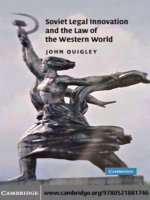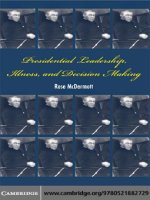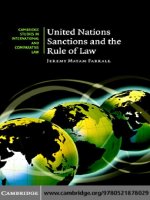0521614899 cambridge university press property law commentary and materials jan 2006
Bạn đang xem bản rút gọn của tài liệu. Xem và tải ngay bản đầy đủ của tài liệu tại đây (3.66 MB, 777 trang )
This page intentionally left blank
Property Law
This is an innovative examination of the law’s treatment of property. It looks at the nature
and function of property rights in resources ranging from land to goods and intangibles,
and provides a detailed analytical exposition of the content, function and effect of the
property rules which regulate our use of these resources, and the fundamental principles
which underpin this structure of rules. It draws on a wide range of materials on property
rights in general and the English property law system in particular. The book includes the
core legal source materials in property law along with readings from social science
literature, legal theory and economics, many of which are not easily accessible to law
students. These materials are accompanied by a critical commentary, as well as notes,
questions and suggestions for further reading.
A L I S O N C L A R K E is Senior Lecturer in Laws at University College London. She has
devised and taught innovative property law courses for undergraduate law students and
specialised postgraduate courses in property-related areas in insolvency and maritime
law. She spent two years seconded to the Law Commission to work on reform of the law of
mortgages and formerly practised as a solicitor in a commercial practice specialising in
land transactions. She has written widely on theoretical aspects of property, with
particular emphasis on communal land rights and evolving patterns of land usage,
whilst continuing to maintain links with law in practice by giving lectures and seminars
to professional lawyers on ship mortgages and commercial property.
P A U L K O H L E R splits his time between academe and business. A former Sub-Dean at
UCL and Head of Best Practice at Nabarro Nathanson, he is currently a law lecturer at
New College, Oxford, and is Chairman of LLT (a legal education provider). He works
with some of the leading law firms in the UK as a knowledge management and change
consultant specializing in the application of new technology to transform working
practices. Paul has devised and taught innovative property courses for over a decade
and researched and written widely in the field.
The Law in Context Series
Editors: William Twining (University College London) and
Christopher McCrudden (Lincoln College, Oxford)
Since 1970 the Law in Context series has been in the forefront of the movement to
broaden the study of law. It has been a vehicle for the publication of innovative scholarly
books that treat law and legal phenomena critically in their social, political, and economic
contexts from a variety of perspectives. The series particularly aims to publish scholarly
legal writing that brings fresh perspectives to bear on new and existing areas of law taught
in universities. A contextual approach involves treating legal subjects broadly, using
materials from other social sciences, and from any other discipline that helps to explain
the operation in practice of the subject under discussion. It is hoped that this orientation
is at once more stimulating and more realistic than the bare exposition of legal rules. The
series includes original books that have a different emphasis from traditional legal textbooks, while maintaining the same high standards of scholarship. They are written
primarily for undergraduate and graduate students of law and of other disciplines, but
most also appeal to a wider readership. In the past, most books in the series have focused
on English law, but recent publications include books on European law, globalisation,
transnational legal processes, and comparative law.
Books in the Series
Anderson, Schum and Twining: Analysis of Evidence
Ashworth: Sentencing and Criminal Justice
Barton & Douglas: Law and Parenthood
Bell: French Legal Cultures
Bercusson: European Labour Law
Birkinshaw: European Public Law
Birkinshaw: Freedom of Information: The Law, the Practice and the Ideal
Cane: Atiyah’s Accidents, Compensation and the Law
Clarke & Kohler: Property Law: Commentary and Materials
Collins: The Law of Contract
Davies: Perspectives on Labour Law
de Sousa Santos: Toward a New Legal Common Sense
Diduck: Law’s Families
Elworthy & Holder: Environmental Protection: Text and Materials
Fortin: Children’s Rights and the Developing Law
Glover-Thomas: Reconstructing Mental Health Law and Policy
Gobert & Punch: Rethinking Corporate Crime
Harlow & Rawlings: Law and Administration: Text and Materials
Harris: An Introduction to Law
Harris: Remedies in Contract and Tort
Harvey: Seeking Asylum in the UK: Problems and Prospects
Hervey & McHale: Health Law and the European Union
Lacey & Wells: Reconstructing Criminal Law
Lewis: Choice and the Legal Order: Rising above Politics
Likosky: Transnational Legal Processes
Maughan & Webb: Lawyering Skills and the Legal Process
Moffat: Trusts Law: Text and Materials
Norrie: Crime, Reason and History
O’Dair: Legal Ethics
Oliver: Common Values and the Public–Private Divide
Oliver & Drewry: The Law and Parliament
Picciotto: International Business Taxation
Reed: Internet Law: Text and Materials
Richardson: Law, Process and Custody
Roberts & Palmer: Dispute Processes: ADR and the Primary Forms
of Decision-Making
Scott & Black: Cranston’s Consumers and the Law
Seneviratne: Ombudsmen: Public Services and Administrative Justice
Stapleton: Product Liability
Turpin: British Government and the Constitution: Text, Cases and Materials
Twining & Miers: How to Do Things with Rules
Twining: Globalisation and Legal Theory
Twining: Rethinking Evidence
Ward: A Critical Introduction to European Law
Ward: Shakespeare and Legal Imagination
Zander: Cases and Materials on the English Legal System
Zander: The Law-Making Process
Property Law
Commentary and Materials
Alison Clarke and Paul Kohler
cambridge university press
Cambridge, New York, Melbourne, Madrid, Cape Town, Singapore, São Paulo
Cambridge University Press
The Edinburgh Building, Cambridge cb2 2ru, UK
Published in the United States of America by Cambridge University Press, New York
www.cambridge.org
Information on this title: www.cambridge.org/9780521614894
© Alison Clarke and Paul Kohler 2005
This publication is in copyright. Subject to statutory exception and to the provision of
relevant collective licensing agreements, no reproduction of any part may take place
without the written permission of Cambridge University Press.
First published in print format 2005
isbn-13
isbn-10
978-0-511-13464-7 eBook (EBL)
0-511-13464-9 eBook (EBL)
isbn-13
isbn-10
978-0-521-61489-4 paperback
0-521-61489-9 paperback
Cambridge University Press has no responsibility for the persistence or accuracy of urls
for external or third-party internet websites referred to in this publication, and does not
guarantee that any content on such websites is, or will remain, accurate or appropriate.
Contents
Preface
Acknowledgments
Table of cases
Table of statutes
Table of statutory instruments
Table of treaties
Table of EC legislation
1
2
page
xvii
xix
xxii
xxxv
xliv
xlv
xlvi
Part 1 The concept of property
1
Property law: the issues
1.1 Basic definition
1.2 Illustrative example
1.2.1 John
1.2.2 Dr A and Dr B and the acquisition and transmission
of property interests
1.2.3 The drugs company: constraints on the exercise of
property rights
3
3
3
4
What we mean by ‘property’
2.1 Introduction
2.1.1 Property as a relationship and as a thing
2.1.2 Conceptualising ‘things’
2.1.3 Distinguishing property rights from other rights
relating to things
2.1.4 Rights and other entitlements: Hohfeld’s rights analysis
2.1.5 Hohfeldian analysis of dynamic property relationships
2.1.6 Property rights, property interests and ownership
2.2 Private property, communal property, state property
and no property
2.2.1 Introduction
2.2.2 Distinguishing no-property, communal property,
state property and private property
13
14
17
17
17
18
18
19
24
26
35
35
36
vii
viii
Contents
2.3
2.4
3
4
Economic analysis of property rights
2.3.1 What economic analysis seeks to achieve
2.3.2 Key concepts in the economic analysis of property
rights
Things as thing and things as wealth
2.4.1 Functions of things
2.4.2 The idea of a fund
2.4.3 Thing versus wealth
2.4.4 Related conceptions
Justifications for property rights
3.1 Introduction: general and specific justifications
3.2 Economic justification of property rights
3.2.1 Property and scarcity
3.2.2 Viability of single property systems
3.2.3 Criteria for measuring the success of a particular
form of ownership
3.3 John Locke’s justification for private property
3.3.1 What Locke was attempting to establish
3.3.2 The political context
3.3.3 The problem of consent
3.3.4 Locke’s justification for original acquisition
3.3.5 The nature of Locke’s commons
3.3.6 Why mixing labour with a thing should give rise
to entitlement
3.3.7 The sufficiency proviso
3.3.8 The spoilation proviso
3.3.9 The theological dimension to Locke’s theory
3.3.10 Present relevance of Locke’s theory
Allocating property rights
4.1 Introduction
4.2 The first occupancy rule
4.2.1 Intuitive ordering
4.2.2 Preservation of public order
4.2.3 Simplicity
4.2.4 Signalling
4.2.5 The bond between person and possessions
4.2.6 The libertarian justification
4.2.7 The communitarian objection
4.2.8 Economic efficiency
4.3 New things
4.4 Capture
42
42
45
50
50
51
51
52
59
59
59
59
78
80
81
81
82
83
83
84
84
87
89
90
90
107
107
108
108
109
110
110
111
111
112
112
122
128
Contents
4.5
Colonisation and property rights
4.5.1 Introduction
4.5.2 The Milirrpum decision and the doctrine of terra nullius
4.5.3 Mabo (No. 2)
4.5.4 Developments since Mabo (No. 2)
138
138
140
143
150
Part 2 The nature of proprietary interests
153
5
Personal and proprietary interests
5.1 Characteristics of proprietary interests
5.1.1 General enforceability
5.1.2 Identifiability of subject-matter
5.1.3 Significance of alienability
5.1.4 Requirement for certainty
5.1.5 The numerus clausus of property interests
5.1.6 Vindication of property rights
5.1.7 Termination
5.1.8 Property rights and insolvency
5.2 Special features of communal property rights
5.2.1 Present scope of communal property
5.3 Aboriginal land rights
5.3.1 Nature of native title
5.3.2 Alienability
5.3.3 Abandonment
5.3.4 Variation
5.3.5 Extent of native title
5.3.6 Is native title proprietary?
155
155
155
156
157
159
159
160
161
163
167
167
173
173
173
174
174
175
175
6
Ownership
6.1 The nature of ownership
6.1.1 The basis of ownership
6.1.2 An outline of the difficulties encountered in
any consideration of ownership
6.2 The contents of ownership
6.2.1 An introduction to Honore´’s analysis
6.3 The roles played by ownership
6.3.1 As a legal term of art
6.3.2 As an amorphous notion
6.4 The limitations of ownership
6.4.1 Nuisance
6.5 Restrictive covenants
180
180
180
Possession
7.1 The nature of possession
7.1.1 Introduction
259
259
259
7
182
192
192
212
212
216
217
217
250
ix
x
Contents
7.1.2 Possession, ownership and proprietary interests
7.1.3 What is possession?
Possession of land
7.2.1 Leases and licences
7.2.2 Possession and particular use rights
Possession of goods: bailment
7.3.1 Nature of bailment
7.3.2 Rights, duties and obligations of bailor and bailee
Protection of possession
7.4.1 Protection of property rights by protection of possession
7.4.2 Tort and the protection of property rights
7.4.3 Self-help remedies
7.4.4 Unlawful eviction and harassment
7.4.5 Trespassing and the criminal law
259
261
271
271
278
280
280
281
282
282
282
286
291
292
Fragmentation of ownership
8.1 Introduction
8.2 Present and future interests
8.2.1 Interests in possession, in reversion and in remainder
8.2.2 Absolute entitlements, contingent entitlements and mere
expectancies
8.2.3 When interests vest
8.2.4 Alienation, management and control
8.2.5 Interests of contingent duration
8.2.6 Requirement of certainty
8.2.7 Successive interests in land and the doctrine of tenures
and estates
8.2.8 Restrictions on the power to create future interests
8.3 Legal and equitable interests
8.3.1 Origin of the legal/equitable distinction
8.3.2 Legal and equitable interests now
8.3.3 The significance of the legal/equitable distinction
8.3.4 Three common fallacies
8.4 Fragmentation of management, control and benefit
8.4.1 Corporate property holding
8.4.2 Managerial property holding
8.5 Group ownership
8.6 General and particular use rights
297
297
297
298
307
311
311
311
312
313
313
320
320
332
339
342
Recognition of new property interests
9.1 Why are certain interests regarded as property?
9.1.1 The function of property
9.1.2 The danger of property
9.1.3 The requirements of property
345
345
345
346
347
7.2
7.3
7.4
8
9
299
302
303
304
306
Contents
9.2
9.3
9.4
9.5
The dynamic nature of property
9.2.1 The recognition and limits of the covenant as a
proprietary interest
9.2.2 The recognition of a proprietary right to occupy
the matrimonial home
The general reluctance to recognise new property rights
9.3.1 The facts of Victoria Park Racing v. Taylor
9.3.2 The views of the majority
9.3.3 The views of the minority
9.3.4 The significance of the case
A comparative confirmation and an economic critique
The future of property
9.5.1 The new property thesis
9.5.2 The emergence of quasi-property
348
349
353
356
356
357
357
358
368
371
373
376
Part 3 The acquisition and disposition of property interests 381
10
Title
10.1 What we mean by ‘title’
10.2 Acquiring title: derivative and original acquisition of title
10.2.1 Derivative acquisition: disposition or grant
10.2.2 Original acquisition
10.3 Relativity of title
10.4 Proving title
10.4.1 Role of registration
10.4.2 Possession as a root of title
10.4.3 Provenance
10.4.4 Extinguishing title by limitation of action rules
10.4.5 Relativity of title and the ius tertii
10.5 The nemo dat rule
10.5.1 Scope of the nemo dat rule
10.5.2 General principles applicable to all property
10.5.3 The application of the nemo dat rule to goods
10.5.4 The application of the nemo dat rule to money
10.5.5 The application of the nemo dat rule to land
10.6 Legal and equitable title
383
383
384
384
384
386
387
388
389
390
391
393
393
394
396
397
398
402
403
11
Acquiring title by possession
11.1 Introduction
11.2 The operation of adverse possession rules
11.2.1 Unregistered land
11.2.2 Registered land
11.2.3 What counts as ‘adverse’ possession
11.2.4 Effect on third party interests
406
406
406
407
407
407
409
xi
xii
Contents
11.3
11.4
11.5
11.6
12
13
Why established possession should defeat the paper owner
Adverse possession and registration
Good faith and the adverse possessor
Goods
11.6.1 Taking and theft
11.6.2 Protection of title by tort
11.6.3 The limitation act 1980 and title to goods
11.6.4 Finders
410
412
413
443
444
444
444
445
Transfer and grant
12.1 Derivative acquisition
12.2 Formalities
12.2.1 Nature and content of formalities rules
12.2.2 Registration and electronic transactions
12.2.3 Validity and enforceability against third parties
12.2.4 Effect of compliance on passing of title
12.2.5 Transactions excepted from formalities rules
12.2.6 Deeds and prescribed forms
12.2.7 Why have formalities rules
12.2.8 Disadvantages
12.3 Contractual rights to property interests
12.3.1 Estate contracts and the rule in Walsh v. Lonsdale
12.3.2 Application to property other than land
12.3.3 The failed formalities rule
12.3.4 Options to purchase, rights of pre-emption and
rights of first refusal
12.4 Unascertained property
12.4.1 The problem of identification
12.4.2 Unascertained goods
12.4.3 Other unascertained property
448
448
448
448
451
452
453
453
454
455
460
471
471
472
473
Acquiring interests by other methods
13.1 Introduction
13.2 The difference between adverse possession and prescription
13.3 Why long use should give rise to entitlement
13.4 Rationale
13.4.1 Ascendancy of the presumed grant rationale
13.4.2 Effect of the ‘revolting fiction’
13.5 When long use gives rise to a prescriptive right
13.5.1 The problem of negative uses
13.5.2 Rights that can be granted but not acquired by
prescription
13.6 User as of right and the problem of acquiescence
13.7 The future of prescription
489
489
489
490
492
492
493
494
494
479
484
484
484
485
496
497
498
Contents
14
15
Enforceability and priority of interests
14.1 Rationale of enforceability and priority rules
14.2 Enforceability and priority rules
14.2.1 The basic rules
14.2.2 Impact of registration
14.3 The doctrine of notice
14.3.1 Notice
14.3.2 Good faith
14.3.3 Effectiveness of the doctrine of notice as an
enforceability rule
14.4 Overreaching
14.4.1 Nature and scope of overreaching
14.4.2 Operation of overreaching
14.4.3 Overreaching the interests of occupying beneficiaries
14.4.4 Transactions capable of overreaching beneficiaries’
interests
14.4.5 The two-trustees rule
512
512
513
513
514
515
516
518
Registration
15.1 What are registration systems for?
15.2 Characteristics of the English land registration system
15.2.1 Privacy
15.2.2 Comprehensiveness
15.2.3 Boundaries
15.2.4 Restricted class of registrable interests
15.2.5 The mirror, curtain and guarantee principles
15.2.6 Consequences of non-registration
15.3 Enforceability and priority of interests under the
Land Registration Act 2002
15.3.1 Registrable interests
15.3.2 All other interests
15.4 Overriding interests
15.4.1 Justifications for overriding interests
15.4.2 Principles to be applied
15.4.3 Overriding interests under the 2002 Act
15.4.4 Easements and profits
15.4.5 Interests of persons in actual occupation: the 1925 Act
15.4.6 Interests of persons in actual occupation: the 2002 Act
15.4.7 Complexity
15.5 Indemnity
15.5.1 Function of indemnity
15.5.2 Shortfall in the provision of indemnity
15.5.3 Cost
537
537
539
539
539
541
541
544
545
519
523
523
524
525
527
529
553
553
554
554
554
555
556
557
558
562
565
566
566
566
567
xiii
xiv
Contents
16
Part 4 Proprietary relationships
569
Co-ownership
16.1 Introduction
16.2 The classical approach to co-ownership: joint tenancies
and tenancies in common
16.2.1 Basic concepts
16.2.2 A comparison of joint tenancies and tenancies in
common
16.2.3 Use of co-owned property
16.2.4 Sale and other dispositions of co-owned property
16.3 Other forms of co-ownership
16.3.1 Commonhold
16.3.2 Unincorporated associations
16.3.3 Extending the limits of co-ownership: public trusts
571
571
572
572
576
591
596
599
599
599
605
17
Leases and bailment
17.1 Introduction
17.2 Leases and bailments compared
17.2.1 Consensuality
17.2.2 Contract
17.2.3 Enforcement
17.2.4 Duration and purpose
17.2.5 Beneficial use
17.2.6 Proprietary status
17.2.7 Inherent obligations of the possessor
17.3 Leases
17.3.1 Nature of the lease
17.3.2 Alienability
17.3.3 Effect of alienation on enforceability
17.4 Bailment
17.4.1 Essential features of bailment
17.4.2 Categories of bailment
17.4.3 Characteristics of bailment
17.4.4 Liabilities of the bailee
17.4.5 Is bailment proprietary?
609
609
609
609
610
610
611
611
612
612
613
613
640
645
648
648
649
650
651
653
18
Security interests
18.1 The nature and function of security
18.1.1 Nature of security
18.1.2 Function
18.1.3 Efficiency
18.1.4 Use of security
657
657
657
658
661
662
Contents
18.2
18.3
18.4
Forms of security
18.2.1 Property transfer securities: the mortgage
18.2.2 Possessory securities: pledge or pawn
18.2.3 Hypothecations: the charge
18.2.4 Liens
18.2.5 Property retention securities
18.2.6 Charge by way of legal mortgage
Control over the terms of the relationship
18.3.1 Equitable supervisory jurisdiction
18.3.2 The Kreglinger principles
18.3.3 Statutory intervention
Enforcement of security
18.4.1 Remedies
18.4.2 Possession
18.4.3 Sale
18.4.4 Duties on enforcement
Bibliography
Index
663
663
664
664
665
665
665
669
669
670
672
684
684
685
686
687
698
709
xv
Preface
Property law tends to be regarded by students as both dull and difficult. The main
objective of this book is to demonstrate that it is neither. The book is based on the
Property Law seminars we devised and taught in the Faculty of Laws at University
College London. Like the seminar course, the book looks at the nature and
function of property rights in resources ranging from land to goods and intangibles, and provides a detailed analytical exposition of the content, function and
effect of the property rules which regulate our use of these resources, and the
fundamental principles which underpin their structure.
We draw on a wide range of materials on property rights in general and our
property law system in particular, including core legal source materials on selected
topics as well as readings from social science literature, legal theory and economics.
Inevitably the coverage is not comprehensive, but we have included notes, questions and suggestions for further reading to provide a starting point for anyone
wanting to take matters further. As in any other property law book, we draw on a
lot of material from decided cases, but to keep the book at a manageable length we
have put most of the edited case extracts we use, together with some other
materials, on the associated website, www.cambridge.org/propertylaw/ rather
than in the book itself. This has enabled us to use much longer extracts than
would otherwise have been feasible, and also to introduce a much wider range of
materials.
We have both been involved in teaching all the topics covered in this book, but
have taken separate responsibility for different parts of the book: Chapters 1–5,
7–8, 10–15 and 17–18 were written by Alison Clarke, and Chapters 6, 9 and 16 by
Paul Kohler.
The content of the book has been greatly influenced by the many stimulating
contributions made to seminars by students over the years, and by our colleagues
who have taught on the seminar course with us at UCL and elsewhere: our thanks
go to all of them, and to our respective families and friends for their help and
encouragement.
xvii
xviii
Preface
Finally, the book is dedicated by Alison to Leo, and by Paul to his partner,
Samantha, and his four daughters, Eloise, Tamara, Bethany and Saskia, whose
endless disputes on the ownership and possession of each other’s clothes has taught
him more about the fundamentals of property than any number of cases in the
Court of Chancery.
ALISON CLARKE
PAUL KOHLER
November 2004
Acknowledgments
We would like to thank the following for permission to reproduce the following
materials:
*
*
*
*
*
*
*
*
*
*
the American Association for the Advancement of Science, Washington, for the
extract from Hardin, ‘The Tragedy of the Commons’ (1968) 162 Science 1243;
Basic Books, for the extracts from Robert Nozick, Anarchy, State, and Utopia,
reprinted by permission of Basic Books, The Perseus Books Group;
Bernard Rudden and Oxford University Press, for the extracts from Rudden,
‘Things as Thing and Things as Wealth’ (1994) 14 Oxford Journal of Legal
Studies 81, and from Lawson and Rudden, The Law of Property (3rd edn,
Oxford: Clarendon Press, 2002);
Carol M. Rose and the University of Chicago Law Review, for the extracts from
Rose, ‘Possession as the Origin of Property’ (1985) 52 University of Chicago Law
Review 73, copyright # 1985 by the University of Chicago;
the Columbia Law Review, for the extract from Lon Fuller, ‘Form and
Consideration’ (1941) 41 Columbia Law Review 799, reprinted with the permission of the Columbia Law Review;
the Council of Mortgage Lenders, for the extract from its Statement of Practice:
Handling of Arrears and Possessions (Council of Mortgage Lenders, 1997);
David Fox, for the extract from his article, ‘Bona Fide Purchase and the
Currency of Money’ (1996) Cambridge Law Journal 547;
David Haddock and the Washington University Law Quarterly, for the extract from
Haddock, ‘First Possession Versus Optimal Timing: Limiting the Dissipation of
Economic Value’ (1986) 64 Washington University Law Quarterly 775;
David Sugarman and Kluwer Law International, for the extract from Sugarman
and Warrington, ‘Telling Stories: Rights and Wrongs of the Equity of
Redemption’, in J. W. Harris (ed.), Property Problems: From Genes to Pension
Funds (London: Kluwer, 1997), reprinted with the permission of Kluwer Law
International;
Dhammika Dharmapala, Rohan Pitchford and the Journal of Law, Economics,
and Organization, for the extract from Dharmapala and Pitchford, ‘An
Economic Analysis of ‘‘Riding to Hounds’’: Pierson v. Post Revisited’ (2002)
xix
xx
Acknowledgments
*
*
*
*
*
*
*
*
*
*
*
*
18 Journal of Law, Economics, and Organization 39, reprinted with permission of
Oxford University Press;
Gregory S. Alexander and the University of Chicago, for the extract from
Alexander, Commodity and Propriety: Competing Visions of Property in
American Legal Thought 1776–1970 (Chicago: University of Chicago Press,
1997), copyright # 1997 by the University of Chicago;
Guido Calabresi, A. Douglas Melamed and the Harvard Law Review, for the
extract from Calabresi and Melamed, ‘Property Rules, Liability Rules and
Inalienability: One View of the Cathedral’ (1972) 85 Harvard Law Review 1089;
Harold Demsetz and the American Economic Association, for the extract from
Demsetz, ‘Towards a Theory of Property Rights’ (1967) 57 American Economic
Review 347;
James Grunebaum and Routledge and Kegan Paul (Taylor & Francis Group),
for the extracts from Grunebaum, Private Ownership (London and New York:
Routledge and Kegan Paul, 1987);
Jeremy Waldron and Oxford University Press, for the extracts from Waldron,
The Right to Private Property (Oxford: Clarendon Press, 1988);
Margaret Jane Radin and the Washington University Law Quarterly, for the
extracts from Radin, ‘Time, Possession, and Alienation’ (1986) 64 Washington
University Law Quarterly 739;
Matthew Kramer, for the extracts from his book, John Locke and the Origins of
Private Property: Philosophical Explorations of Individualism, Community, and
Equality (Cambridge: Cambridge University Press, 1997);
New York University Press, for the extracts from J. Roland Pennock and John
Chapman (eds.), Nomos XXII: Property (New York: New York University Press,
1980);
Oxford University Press, for the extracts from A. M. Honore´, Making Law Bind
(Oxford: Clarendon Press, 1987), from Markesinis and Deakin, Markesinis and
Deakin’s Tort Law (5th edn, Oxford: Clarendon Press, 2003), from Alison
Clarke, ‘Property Law’ (1992) 45 Current Legal Problems Annual Review, and
‘Use, Time and Entitlement’ (2004) 57 Current Legal Problems 239, from Peter
Birks, ‘Five Keys to Land Law’, in S. Bright and J. Dewar (eds.), Land Law:
Themes and Perspectives (Oxford: Oxford University Press, 1998), and from
A. W. B. Simpson, A History of the Land Law (2nd edn, Oxford: Clarendon
Press, 1986);
Paddy Ireland and the Modern Law Review, for the extract from Ireland,
‘Company Law and the Myth of Shareholder Ownership’ (1999) 62 Modern
Law Review 32;
Peter Luther, for the extract from his article, ‘Williams v. Hensman and the Uses
of History’ (1995) 15 Legal Studies 219;
Princeton University Press, Terry L. Anderson and Fred McChesney (eds.),
Property Rights: Co-operation, Conflict, and Law (Princeton: Princeton
University Press, 2003), reprinted by permission of Princeton University Press;
Acknowledgments
*
*
*
*
*
*
*
*
*
*
Richard A. Epstein and the Washington University Law Quarterly, for the
extracts from Epstein, ‘Past and Future: The Temporal Dimension in the Law
of Property’ (1986) 64 Washington University Law Quarterly 667;
Richard Posner and Aspen Publishers, for the extract reprinted from Posner,
Economic Analysis of Law (6th edn, New York: Aspen Publishers, 2002), with the
permission of Aspen Publishers;
Robert Ellickson and the Journal of Law, Economics, and Organization, for the
extract from ‘A Hypothesis of Wealth-Maximising Norms: Evidence from the
Whaling Industry’ (1989) 5 Journal of Law, Economics, and Organization 83,
reprinted with permission of Oxford University Press;
Roy Goode and Penguin Books, for the extract from R. M. Goode, Commercial
Law (2nd edn, London: Penguin Books, 1995), reproduced by permission of
Penguin Books Ltd;
Stephen Munzer, for the extract from A Theory of Property (Cambridge:
Cambridge University Press, 1990);
Sweet & Maxwell and Tony Weir, for the extract from Weir, A Casebook on Tort
(10th edn, London: Sweet & Maxwell, 2004);
Sweet & Maxwell, for the extract from Roper et al., Ruoff and Roper on the Law
and Practice of Registered Conveyancing (2nd looseleaf edn, London: Sweet &
Maxwell, 2003);
Transaction Publishers, for the extract from Adolf A. Berle and Gardiner C.
Means, The Modern Corporation and Private Property (New York: Harcourt,
Brace & World, 1932), reprinted with the permission of Transaction Publishers;
the Yale Law Journal Company and William S. Hein Company, for the extract
from Hohfeld, ‘Fundamental Legal Conceptions as Applied in Judicial
Reasoning’ (1913) 23 Yale Law Journal 16; and
Yoram Barzel, for the extract from his book, Economic Analysis of Property
Rights (2nd edn, Cambridge: Cambridge University Press, 1997)
Felix S. Cohen, ‘Dialogue on Private Property’, was first published in (1954) 9
Rutgers Law Journal 357 and is reprinted with permission.
Crown copyright material is reproduced with the permission of the Controller
of HMSO and the Queen’s Printer for Scotland.
xxi
Table of cases
A-G v. Antrobus [1905] 2 Ch 188 503
A-G v. Doughty (1752) 2 Ves Sen 453 497
A-G v. Pawlett (1667) Hard 465 675
A-G and Newton Abbot RDC v. Dyer [1947] Ch 67 506, 510
A-G (ex rel. Yorkshire Derwent Trust Ltd) v. Brotherton [1991] 3 WLR 1126,
HL 602
A-G for Ontario v. Orange Productions Ltd, 21 DLR (3d) 257 (1971) 218
Abbey National Building Society v. Cann [1991] 1 AC 56, HL 561
Abbey National plc v. Moss [1994] 1 FLR 307, CA 598
Ackroyd v. Smith 10 CB 164 166
Advocate (Lord) v. Young (1887) LR 12 App Cas 544, HL 264
AG Securities v. Vaughan, Antoniades v. Villiers [1998] 2 All ER 173, CA rvsd
[1990] AC 417, HL 274, 275, 278, 578, 579
Agard v. King (1600) Cro Eliz 775 620
Agnew v. IRC [2001] UKPC 28, [2001] 2 AC 710, [2001] 3 WLR 454 665, 668
Ahmed v. Kendrick (1988) 56 P&CR 120 582
AIB Finance v. Debtors [1997] 4 All ER 677 affd [1998] 2 All ER 929, CA 686, 696
Albany Home Loans Ltd v. Massey [1997] 2 All ER 609, CA 685, 695, 696, 697
Aldred’s Case 9 Co Rep 57b 497
Aliakmon, The. See Leigh and Sillivan Ltd v. Aliakmon Shipping Co. Ltd, The
Aliakmon
Allen v. Flood [1898] AC 1, HL 31
Aluminium Industrie Vaassen BV v. Romalpa Aluminium Ltd [1976] 1 WLR 676,
CA 665
American Express International Banking Corp v. Hurley [1985] 3 All ER 564 696
Antoniades v. Villiers [1988] 3 WLR 139, CA rvsd [1990] AC 417, HL sub nom AG
Securities v. Vaughan, Antoniades v. Villiers 578
Ashburn Anstalt v. Arnold [1989] Ch 1, CA 156, 564
Ashworth Frazer Ltd v. Gloucester City Council [2001] 1 WLR 2180, HL 645
Atwood v. Bovis Homes Ltd [2000] 3 WLR 1842 343
AVX Ltd v. EGM Solders Ltd (1982) Times, 7 July 650, 651, 653
Ayerst (Inspector of Taxes) v. C & K (Construction) Ltd [1976] AC 167, HL 338, 339
xxii
Table of cases
Bacon (MC) Ltd, Re [1990] BCC 78 658
Baker v. Archer-Shee [1927] AC 844, HL 335
Bakewell Management Ltd v. Brandwood [2004] UKHL 14 491
Bamford v. Turnley (1862) 3 B&S 66, 122 ER 27, [1861–73] All ER Rep 706 366
Bank of New Zealand v. Greenwood [1984] 1 NZLR 525, NZ HC 234
Barclays Bank Ltd v. Quistclose Investments Ltd [1970] AC 567, HL 318
Barker v. Stickney [1919] 1 KB 121, CA 350, 352
Bashall v. Bashall (1894) 11 TLR 152, CA 469
Bates v. Donaldson [1896] 2 QB 241, CA 644
Beckett Ltd (Alfred F) v. Lyons [1967] Ch 449, CA 506
Bettison v. Langton [2001] UKHL 24 40, 167, 168, 170, 171, 542
BHP Petroleum Great Britain Ltd v. Chesterfield Properties Ltd [2002]
2 WLR 672, CA 647
Billson v. Residential Apartments Ltd [1991] 3 WLR 264, CA rvsd [1992] 1 AC 494,
HL 288, 289
Bircham & Co., Nominees (2) Ltd v. Worrell Holdings Ltd [2001] EWCA Civ
775 479, 480, 481, 484
Bishop of Bath’s Case, The 6 Co Rep 35b 620
Bishopsgate Motor Finance Corp Ltd v. Transport Brakes Ltd [1949] 1 KB
322 394, 395, 396
Blount v. Layard [1891] 2 Ch 681n, CA 506
Bollinger v. Costa Brava Wine Co. Ltd [1960] Ch 262 378
Boyle’s Claim, Re [1961] 1 WLR 339 567
Bradford Corp v. Pickles [1895] AC 587, HL 224, 234, 495
Breen v. Williams (1995–6) 186 CLR 71, Aus HC 378
Bridges v. Hawkesworth (1851) 21 LJ QB 75 267
Bristol Airport plc v. Powdrill. See Paramount Airways Ltd, Re, Bristol Airport plc
v. Powdrill
Bristol & West Building Society v. Henning [1985] 2 All ER 606, CA 584
British Telecommunications plc v. One in a Million Ltd [1999] 1 WLR 903, CA 378
Broadwick Financial Services Ltd v. Spencer [2002] EWCA Civ 35, [2002] 1 All ER
(Comm) 446 670, 673, 683, 684
Brown & Root Technology Ltd v. Sun Alliance and London Assurance Co. Ltd
[2000] 2 WLR 566, CA 552
Brunner v. Greenslade [1971] Ch 993 252
Bruton v. London & Quadrant Housing Trust [1998] QB 834, [1997] 4 All ER 970,
[1998] 3 WLR 438, CA rvsd [2000] 1 AC 406, [1999] 3 WLR 150, HL 272, 276,
277, 403, 612, 637, 638, 639, 640
Bryant v. Foot (1867) LR 2 QB 161 500, 502
Buchanan-Wollaston’s Conveyance, Re, Curtis v. Buchanan-Wollaston [1939] Ch
738, CA 597
Buckinghamshire County Council v. Moran [1990] Ch 623, CA 267, 408, 432,
438, 443
xxiii









